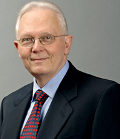J. Michael Steele

- C.F. Koo Professor Emeritus of Statistics
Contact Information
- Primary Email:
steele@wharton.upenn.edu
Research Interests: applications of probability, mathematical finance, modeling of price processes, statistical modeling
Links: Personal Website
Activity
Latest Research
V. Pozdnyakov and J. Michael Steele, “Scan Statistics: Pattern Relations and Martingale Methods”. In Handbook of Scan Statistics, edited by (J. Glaz, et al), Springer Verlag, (2019)
All ResearchIn the News
Polling the Polling Experts: How Accurate and Useful Are Polls These Days?Turn on the Internet, pick up your telephone or cell phone, read a newspaper or watch television: No matter what the communication vehicle is, polls and the reporting of poll results are ubiquitous. Yet how accurate are polls? Can they be manipulated? How do the Internet and the proliferation of cell phone users affect both marketing and political polls? And which polls are the most reliable? Knowledge at Wharton interviewed the experts.…Read More
Knowledge at Wharton - 11/14/2007

